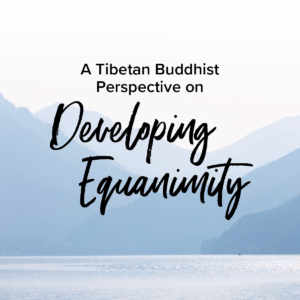What is Equanimity in Tibetan Buddhism?
Generally speaking, equanimity is the absence of biased attitudes of feeling close to some living beings and distant from others. According to Tibetan Buddhism when we meditate on equanimity in the context of The Four Boundless Thoughts, it is the wish for all beings to be free from their attachment to their close ones and aversion to those who are distant from them. Hint: The keyword is ALL, not just our loved ones or friends but all beings. Remember this is a practice, so we can let go of the expectation of instant mastery. Developing equanimity requires time and concentrated effort.
Why is developing equanimity helpful?
Developing equanimity is helpful because it allows us to train ourselves away from biased attitudes. One way to contemplate this is by considering that the people closest to us in this life or another lifetime may have been the ones who hurt us the most in a different lifetime.
On the other hand, those people who we think would never do anything good for us in our current lives could have been helpful to us in another lifetime. Yes, those are a lot of lifetimes to consider. However, it is helpful to our equanimity development to zoom out and consider more than this current lifetime. This contemplation can help us release strong attachments to those we are currently close to and can help ease our aversion to people we tend to avoid.
How to maintain equanimity when we encounter stressful situations or people?
When we realize that there is potential for good and bad in every relationship and every situation, we start to feel a more equal attitude. Developing compassion for all living beings is a lofty goal. It is common to struggle on that journey. It doesn’t feel good to admit, but most of us have at least one person we struggle to like. It can be challenging to understand why we should want them to be free from suffering. We can begin with these contemplations and learn to see the bigger picture, that we perpetuate our own suffering by not developing equanimity.
What’s an example of equanimity?
When we encounter people or experiences that we don’t like, whether it’s because we have opposing viewpoints, or we feel it’s harmful to ourselves or our society, we label them as bad. If we start digging deeper and think about it, we realize that we are all suffering for the same reasons of grasping at self, a misapprehension of reality. Thus, we are all equal.
Why do we need equanimity?
No one wants to suffer, everyone wants happiness. But sometimes we struggle to understand the causes of happiness and suffering. The causes of suffering are self-grasping, afflictive emotions, and doing harmful actions. Most of us claim to not want to suffer, but we often continue to engage in the causes of suffering.
The causes of happiness are the virtuous states of love and compassion, wholesome actions, and the wisdom of emptiness. Often, we claim to want to be happy but don’t make efforts to engage in the causes of happiness. If we wish for happiness, we have to take steps to reach it. If we want to avoid suffering, we have to abandon its causes.
When we see the truth of this, we see that everyone’s suffering is due to a lack of understanding of the basic causes of happiness and suffering, and thereby see that everyone is equally deserving of our patience, love, and compassion. Hearing this once won’t cause a radical change in most of our minds, so we need to think about this carefully and contemplate it again and again.
It will be challenging, if not impossible, to cultivate equanimity if we believe in the idea of a solid, permanent, and truly existing person. If we believe that people are unchangeable and not a product of causes and conditions, it will be difficult to develop compassion and equanimity towards them. It’s important to remember that everyone is conditioned by their life experiences, family of origin, their past karma, and more.
What are some meditation practices for cultivating equanimity?
With any state of mind, you have the mind itself, an object, and a way that the mind appears in relation to the object. When practicing equanimity, the object is all living beings who have attachment to their friends, family, and loved ones, and aversion to those who are distant—those who aren’t included in that sphere of concern. The way that our mind appears in relation to that object is as a wish for all living beings to be free from the biases of attachment to those who are close and aversion to those who are distant. But in the beginning, our own biases may not allow us to make so that wish for all beings. We need help bringing our own minds to that state of equanimity.
In the process of the Four Boundless Thoughts it’s often advisable for us to begin with an equanimity practice. Otherwise we will have a biased attitude which prevents us from developing equal love and compassion for all beings. We will only have biased love and biased compassion for those closest to us without being able to develop it for those outside our sphere of care.
The one aspect that makes boundless attitudes boundless is that they are focused on all sentient beings, not just the ones that we like. The only way to develop an equal attitude of compassion for all beings is by first developing a sense of equanimity in our minds towards all living beings.
Two primary ways to accomplish that are:
- Seeing that all beings have been our mothers in previous lives.
- Seeing that all beings are equal in being selfless due to the nature of emptiness.
Equanimity Practice #1:
The first of those can be quite difficult to fathom for those of us who may not have conviction in the principle of past and future lives, but in brief it means that if we are living in a world in which we have taken infinite previous births, then all living beings have at one time or another been our mother and cared for us by giving us life, giving us food, protecting us from danger, and so forth as has our mother figure of this life. If we can see all living beings in that way, then we can see that they are all equally worthy of our care, love, and respect.
Equanimity Practice #2:
The second of those methods is to see the selflessness or emptiness of all beings. To do that we need to go through the process of analytic meditations found in the Vipassana teachings. In those teachings, we reflect upon our minds and bodies and learn that the self is a mental imputation or mere idea that is conceived in our minds.
When we investigate our minds and bodies, and dissect them piece by piece, we never find any singular, solid, or truly existing self. All we can find are things that we think of as “my”, such as “my head”, “my body”, “my mind”, and so forth, but we never find “me.” In the process of habitually grasping at this falsely imagined self, we believe in the truth of things. When we believe that things really exist in the way that they appear to our minds, then everything that we are doing in that process is furthering our habitual patterns and furthering our experiences of suffering.
If we learn that our own and everyone’s self-grasping comes from an ignorance of our fundamental nature of emptiness or selflessness, we begin to understand equanimity. We can begin to see that everyone is suffering needlessly due to this root cause of ignorance. When we understand that, we gain the equanimity to see that all beings are equally deserving of our love and concern.
Alright, now we know the what, why, and how of equanimity. Got it?! Kidding, kidding! Reading this blog alone probably won’t be enough for you to develop a mind and attitude of equanimity, but we hope this helps on your journey. Remember to cultivate compassion for yourself as you work towards an equanimous mind. You won’t be perfect, but you can always start again.
Learn more about equanimity in this short clip of Lama Tsomo from our Four Immeasurables Retreat.
